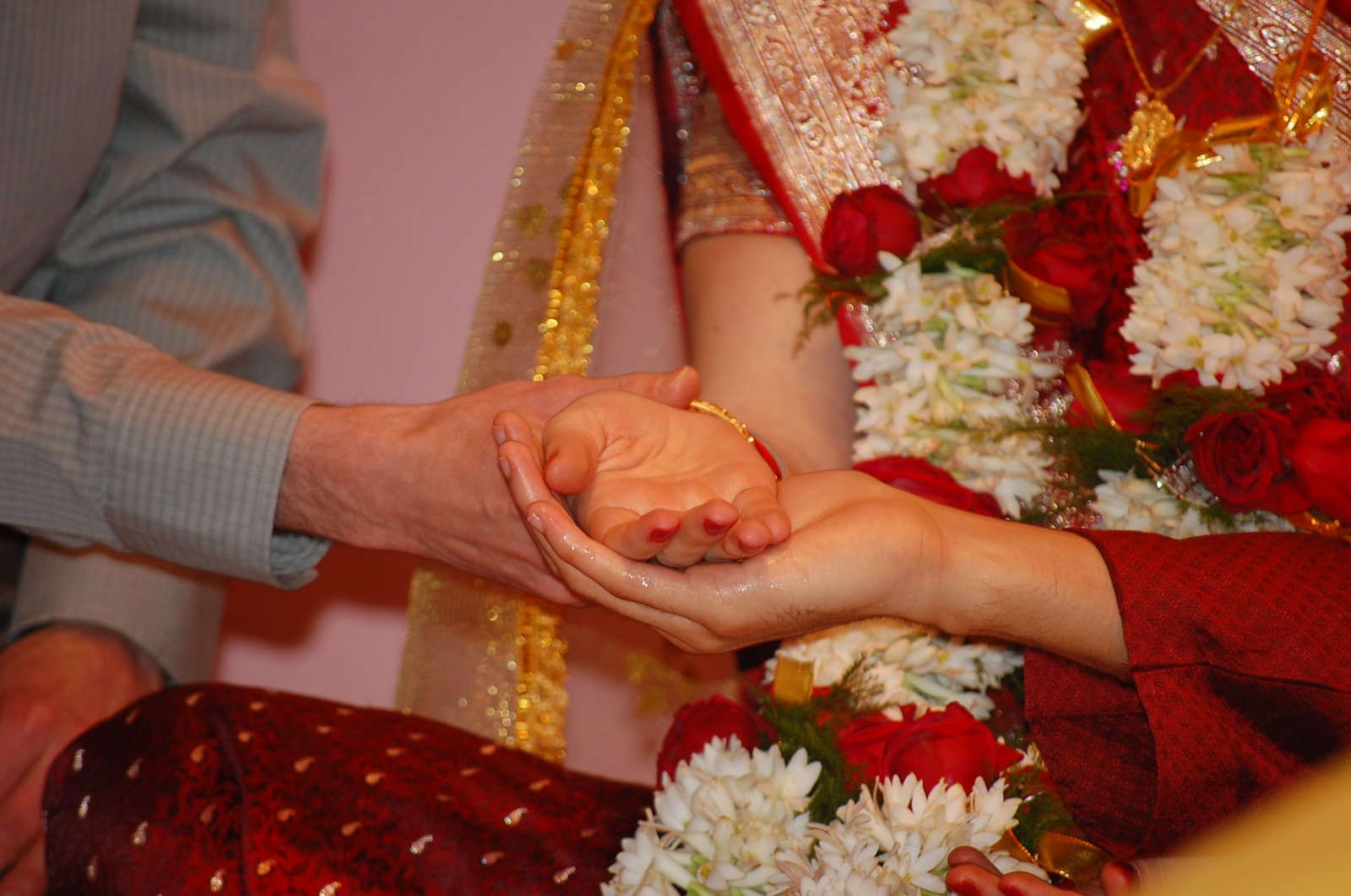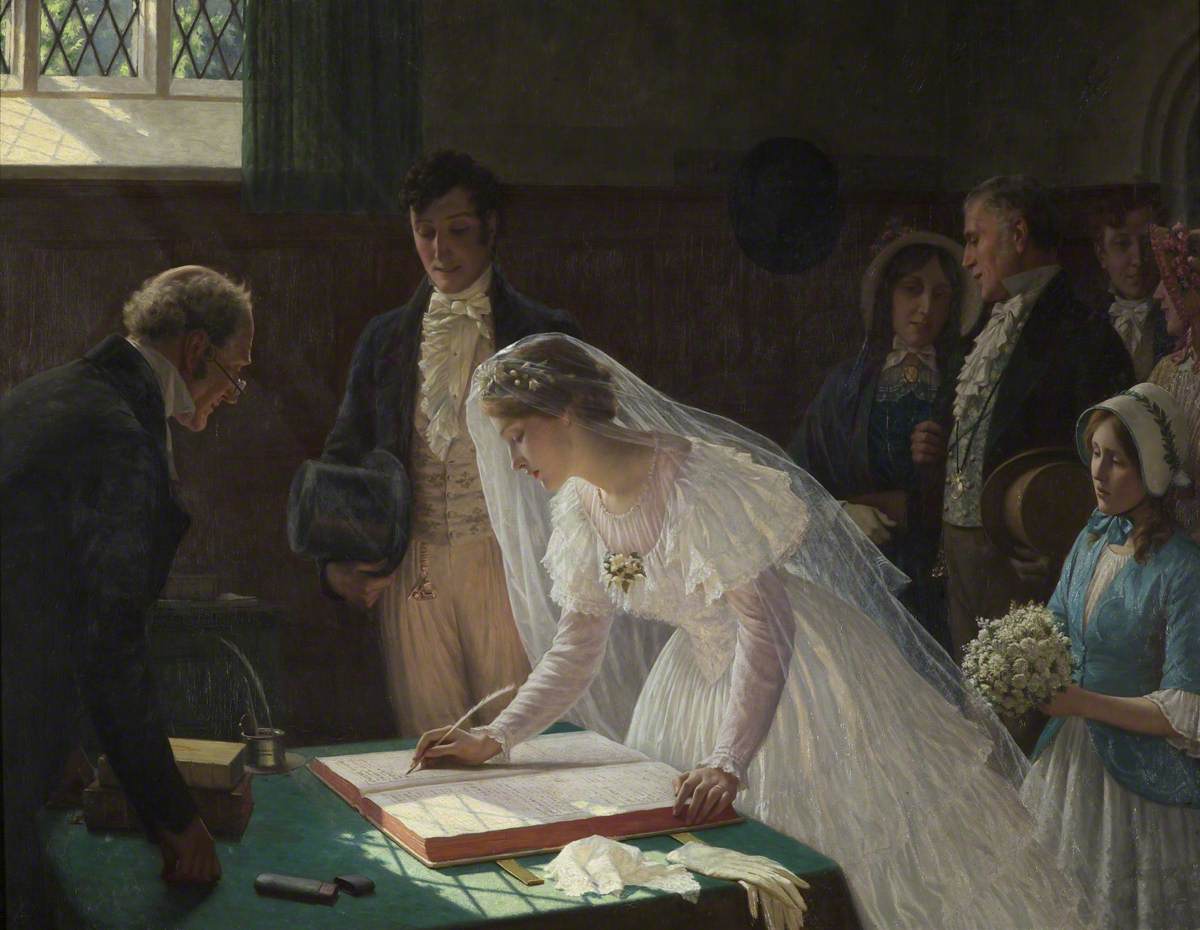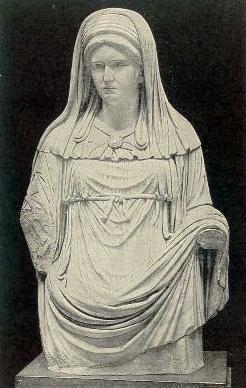|
Bride
A bride is a woman who is about to be married or who is a newlywed. When marrying, if the bride's future spouse is a man, he is usually referred to as the ''bridegroom'' or just ''groom''. In Western culture, a bride may be attended by a maid, bridesman and one or more bridesmaids. The word "bride" has its roots in the Old English word ''bryd'', which is shared with other Germanic languages. In Western countries, brides typically wear white wedding dresses, a tradition started by Queen Victoria. The white dress was once considered a symbol of luxury due to the difficulties in laundering delicate white clothing. Today, Western brides may wear white, cream, or ivory dresses, regardless of their number of marriages. In non-Western countries, brides often wear national dress, with white wedding dresses being uncommon in Asian cultures as it symbolizes mourning and death. Red, on the other hand, represents vibrancy and health and is commonly worn by brides in many Asian cultures. Br ... [...More Info...] [...Related Items...] OR: [Wikipedia] [Google] [Baidu] |
Hindu Wedding
A Hindu wedding, also known as (, ) in Hindi, () in Marathi, () in Bhojpuri, () in Bengali, () or () in Odia, () in Tamil, () in Telugu, () in Kannada, and ''kalyanam'' (, ; ) in Malayalam and other languages, is the traditional marriage ceremony for Hindus. The weddings are very colourful, and celebrations may extend for several days and usually a large number of people attend the wedding functions. The bride's and groom's homes—entrance, doors, walls, floor, roof—are sometimes decorated with colors, flowers, lights and other decorations.Yee, A. (2008 May 17Sari nights and henna parties ''The Financial Times''. The word ''vivāha'' originated as a sacred union of two people as per Vedic traditions, i.e. what many call marriage, but based on cosmic laws and advanced ancient practices. Under Vedic Hindu traditions, marriage is viewed as one of the saṁskāras performed during the life of a human being, which are lifelong commitments of one wife and one hu ... [...More Info...] [...Related Items...] OR: [Wikipedia] [Google] [Baidu] |
Wedding
A wedding is a ceremony in which two people are united in marriage. Wedding traditions and customs vary greatly between cultures, ethnicity, ethnicities, Race (human categorization), races, religions, Religious denomination, denominations, Country, countries, social classes, and sexual orientations. Most wedding ceremonies involve an exchange of marriage vows by a couple; a presentation of a gift (e.g., an offering, rings, a symbolic item, flowers, money, or a dress); and a public proclamation of marriage by an authority figure or Celebrant (Australia), celebrant. Special wedding garments are often worn, and the ceremony is sometimes followed by a wedding reception. Music, poetry, prayers, or readings from religious texts or literature are also commonly incorporated into the ceremony, as well as Wedding superstitions, superstitious customs. Common elements across cultures Some cultures have adopted the traditional Western custom of the white wedding, in which a bride wear ... [...More Info...] [...Related Items...] OR: [Wikipedia] [Google] [Baidu] |
Bridesmaid
Bridesmaids are members of the bride's party at some Western traditional wedding ceremonies. A bridesmaid is typically a young woman and often the bride's close friend or relative. She attends to the bride on the day of a wedding or marriage ceremony. Traditionally, bridesmaids were chosen from unwed young women of marriageable age. The principal bridesmaid, if one is designated, may be called the chief bridesmaid. She may also be called the maid of honor if she is unmarried, or the matron of honor if she is married. A junior bridesmaid is a girl who is clearly too young to be married but who is included as a bridesmaid anyway. In the United States, typically only the maid or matron of honor and the best man are considered official witnesses for the wedding license. Often there is more than one bridesmaid; in modern times the bride chooses how many to ask. Historically, no person of status went out unattended, and the size of the retinue was closely calculated to be appropriat ... [...More Info...] [...Related Items...] OR: [Wikipedia] [Google] [Baidu] |
Married
Marriage, also called matrimony or wedlock, is a culturally and often legally recognised union between people called spouses. It establishes rights and obligations between them, as well as between them and their children (if any), and between them and their Affinity (law), in-laws. It is nearly a cultural universal, but the definition of marriage varies between cultures and religions, and over time. Typically, it is an institution in which interpersonal relationships, usually sexual, are acknowledged or sanctioned. In some cultures, marriage is recommended or considered to be Premarital sex, compulsory before pursuing sexual activity. A marriage ceremony is called a wedding, while a private marriage is sometimes called an elopement. Around the world, there has been a general trend towards ensuring Women's rights, equal rights for women and ending discrimination and harassment against couples who are Interethnic marriage, interethnic, Interracial marriage, interracial, In ... [...More Info...] [...Related Items...] OR: [Wikipedia] [Google] [Baidu] |
Wedding Dress
A wedding dress or bridal gown is the dress worn by the bride during a wedding ceremony. The color, style and ceremonial importance of the gown can depend on the religion and culture of the wedding participants. Wedding dresses hold a significant place in fashion, symbolizing personal expression, and cultural traditions and societal values. In Western culture, Western culture, the wedding dress is most commonly white, a fashion made popular by Queen Victoria when she married in 1840. In Eastern world, Eastern cultures, brides often choose red to symbolize auspiciousness. These wedding dresses often represent a blend of heritage and contemporary trends, making them a pivotal aspect of bridal fashion and a reflection of evolving style in society. Fashion of wedding dresses Wedding dress fashion has evolved significantly, shaped by shifts in aesthetic preferences, technological advancements, and broader cultural trends. Historically, bridal attire featured elaborate designs with ... [...More Info...] [...Related Items...] OR: [Wikipedia] [Google] [Baidu] |
White Wedding
A white wedding is a traditional formal wear, formal or semi-formal wear, semi-formal wedding originating in Great Britain. The term originates from the white colour of the wedding dress, popularised by Victorian era elites after Queen Victoria wore a white lace dress at her Wedding of Queen Victoria and Prince Albert of Saxe-Coburg and Gotha, 1840 wedding to Albert, Prince Consort, Prince Albert. The white wedding style was given another significant boost in 1981, when 750 million people watched Wedding of Prince Charles and Lady Diana Spencer, the wedding of Diana, Princess of Wales, Diana Spencer to Charles III, Charles, Prince of Wales, which saw her wear Wedding dress of Lady Diana Spencer, an elaborate white taffeta dress with an 8 m train. The full white wedding experience today typically requires the family to arrange for or purchase printed or engraved wedding invitations, musicians, decorations such as flowers or candles, clothes and flowers for bridesmaids, groomsmen, ... [...More Info...] [...Related Items...] OR: [Wikipedia] [Google] [Baidu] |
Veil
A veil is an article of clothing or hanging cloth that is intended to cover some part of the human head, head or face, or an object of some significance. Veiling has a long history in European, Asian, and African societies. The practice has been prominent in different forms in Judaism, Christianity, and Islam. The practice of veiling is especially associated with women and sacred objects, though in some cultures, it is men, rather than women, who are expected to wear a veil. Besides its enduring religious significance, veiling continues to play a role in some modern secular contexts, such as wedding customs. History Antiquity Elite women in ancient Mesopotamia and in the Rise of Macedon, Macedonian and Persian Empire, Persian empires wore the veil as a sign of respectability and high status. The earliest attested reference to veiling is found a Middle Assyrian Empire, Middle Assyrian law code dating from between 1400 and 1100 BC. Assyria had explicit sumptuary laws detailin ... [...More Info...] [...Related Items...] OR: [Wikipedia] [Google] [Baidu] |
Bridegroom
A bridegroom (often shortened to groom) is a man who is about to be married or who is newlywed. When marrying, the bridegroom's future spouse is usually referred to as the bride. A bridegroom is typically attended by a best man and groomsmen. Etymology The first mention of the term ''bridegroom'' dates to 1572, from the Old English ''brȳdguma'', a compound of ''brȳd'' (bride) and ''guma'' (man, human being, hero). It is related to the Old Saxon ''brūdigomo'', the Old High German ''brūtigomo'', the German ''Bräutigam'', and the Old Norse ''brúðgumi''. Attire The style of the bridegroom's clothing can be influenced by many factors, including the time of day, the location of the ceremony, the ethnic backgrounds of the bride and bridegroom, the type of ceremony, and whether the bridegroom is a member of the Armed Forces. National or ethnic traditions * In the United States, the bridegroom usually wears a dark-colored suit for a daytime wedding or a tuxedo for an ... [...More Info...] [...Related Items...] OR: [Wikipedia] [Google] [Baidu] |
Wedding Rings
A wedding ring or wedding band is a finger ring that indicates that its wearer is married. It is usually forged from metal, traditionally gold or another precious metal. Rings were used in ancient Rome during marriage. In western culture, a wedding ring is typically worn on the base of the left ring finger. The ring finger is widely claimed to be associated with the traditional belief known as ''vena amoris'' ("vein of love"). History The Western traditions of wedding rings can be traced to ancient Rome and Greece, and were first associated with the marital dowry and later with a promise of fidelity. The modern exchange of rings derived from the customs of Europe in the Middle Ages as part of Christendom. Historical styles Gimmel rings During the 16th and 17th centuries, European husbands bestowed a gimmel ring upon their wives. Similar to the puzzle ring, the gimmel ring consisted of two interlocking bands. The bride and groom both wore one of these bands after thei ... [...More Info...] [...Related Items...] OR: [Wikipedia] [Google] [Baidu] |
Choora
''Chura'' (in Hindi-Urdu), ''chuda'', or ''chudlo'' (in Gujarati) is a set of bangles traditionally worn by a bride on her wedding day and for a period after, especially in Indian weddings. Materials and appearance The ''chura'' is usually red and white; sometimes the red bangles are replaced with another colour, but they are usually only two colours. They are traditionally made of ivory, with inlay work, though now made with plastic. Traditionally there are 21 bangles, although more recently the bride often wears 7, 9 or 11 bangles. The bangles range in size according to the circumference of the top of the forearm and the wrist end so that the set fits neatly. Gujarati chudlo In Gujarati tradition, the bridal bangles are referred to as ''chudlo'' (). Traditionally they were made using elephant's tusks/ivory and were known as "''haathi daant no chudlo"''. These bangles are gifted to the bride by her maternal uncle. ''Chudlo'' is generally paired with Gujarati bridal sari k ... [...More Info...] [...Related Items...] OR: [Wikipedia] [Google] [Baidu] |
Bridesman
A bridesman is a close male friend and/or relative of the bride, one who walks down the aisle in the bridal ceremony in the traditional place of a bridesmaid. Charlotte Brontë made reference to bridesmen, seemingly in the modern sense, in the final chapter of her 1859 novel ''Shirley'', which is set in Yorkshire in 1811–12: "Amongst the bridal train the most noticeable personages were the youthful bridesmen, Henry Sympson and Martin Yorke." The term, however, has an ancient and obscure, possibly confabulated origin. The term is first noted by the Encyclopaedia Judaica from the European Jewish Diaspora of the middle of the 13th century. In this context, a bridesman was not a friend of the bride but of the groom. He paid for and arranged the wedding from his own money and would be repaid someday by the groom. It was a position of the highest level of honor in male friendship. It was akin to the modern-day best man. In Hungary Hungary is a landlocked country in Central ... [...More Info...] [...Related Items...] OR: [Wikipedia] [Google] [Baidu] |
Wedding Dress Of Queen Victoria
Queen Victoria of the United Kingdom married Prince Albert of Saxe-Coburg and Gotha on 10 February 1840. She chose to wear a white wedding dress made from heavy silk satin, making her one of the first women to wear white for their wedding. The Honiton lace used for her wedding dress proved an important boost to Devon lace-making. Queen Victoria has been credited with starting the tradition of white weddings and white bridal gowns, although she was not the first royal to be married in white. Design The lace was designed by William Dyce, head of the then Government School of Design (later known as the Royal College of Art), and mounted on a white satin dress made by Mary Bettans. The plain, cream-coloured satin gown was made from fabric woven in Spitalfields, east London, and trimmed with a deep flounce and trimmings of lace hand-made in Honiton and Beer, in Devon. This demonstrated support for English industry, particularly the cottage industry for lace. The handmade lace m ... [...More Info...] [...Related Items...] OR: [Wikipedia] [Google] [Baidu] |






